Via I Maggio
Excavations that were carried out in 1980-2 under a house in Via I Maggio (near the junction with Viale Properzio), an area that was within the Roman walls (albeit that it is outside the medieval circuit) uncovered finds come from two distinct periods:
-
✴those from the lowest level of the excavations came from what seems to have been an archaic settlement ( 7th century BC) here; while
-
✴the finds in the level above came from a cult site.
The cult site seems to have been formed by two pools or basins enclosed by walls and joined by a corridor some 16 meters long. The complex was apparently first monumentalised in the 3rd century BC, when the earlier of the two pools was built in the south west corner of the complex. A number of ceramic votive objects found during the excavations date to this period.
The cult site was extended and restored at the time of the Emperor Hadrian (117-38 AD). The upper levels of the first pool and all of the second pool belong to this phase of development.
Coin Hoards
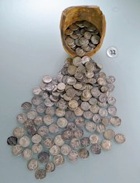
A hoard of some 900 coins, which included dateable coins from the period 211-115 BC, was found outside Porta Foligno in 1929. Part of this hoard is displayed in the Museo Archeologico, Perugia. Unfortunately, the other part, which was exhibited locally, was later stolen.
Cult of Valetudo
A large number of inscriptions (see below) from Bevagna attest to the particular importance in Mevania of the cult of the Italic goddess Valetudo. Giuseppina Prosperi Valenti (2006, referenced below) pointed out that many of these were found in the area between the Campo dei Frati, the ex-Campo Sportivo and Viale Properzio, which suggests that this was the site of a sanctuary dedicated to the goddess. It is possible that this was the dedication of the cult site described above.
Valetudo was the goddess of health and public welfare, and seems to have been particularly associated with sources of water that were deemed to be therapeutic. She seems to be related to the Greek goddess Hygeia, a daughter of Asclepius: while Asclepius was associated with healing, Hygeia was associated more specifically with the prevention of sickness and the continuation of good health. (Her name is the source of the word "hygiene").
-
✴The cult of Hygeia was documented in Mevania by an inscription (CIL XI 5025, date ??) on an altar (now lost)that was once in the garden of the former convent of San Paolo dei Cappuccini, which read “(H)ygiae sacrum”.
-
✴A statue (date?) of Asclepius, which was found in a Roman domus in Bevagna in the 18th century, was taken to Rome in 1812 and is now in the Sala delle Colombe, Palazzo Nuovo, part of the Museo Capitolino, Rome.
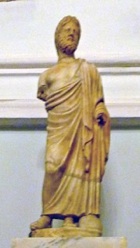
Valetudo might also be associated with ancient Roman goddess of social welfare, Salus: a silver denarius (49 BC), which was minted in Rome by Manius Acilius Glabrio, has a bust of Salus on one side and a figure of Valetudo holding a sacred snake on the other.
Most of the inscriptions from Bevagna that relate to this cult also record the college of priests that presided over it. This is alternatively defined as the Magistri Valetudinis or Novemviri Valetudinis, a magistracy of nine men (usually freedmen). Three of the inscriptions commemorate men who also belonged to another priestly college, the Seviri Sacris Faciundis. Neither college is known to have existed elsewhere.
Magistri Valetudinis
Mensa dei Magistri Valetudinis
This inscription (CIL XI 7926), 1st century AD) is on an altar table, was found in the 18th century in what is now Parco Silvestri, which was probably within the walls of the Roman city. [Now in the Antiquarium del Mosaico Romano ?]. The surviving part of the inscription was in two parts:
-
✴The inscription on the left side reads:
-
Mag(istri) Valet(udinis) Q(uintus) Aemilius Q(uinti) l(ibertus) Epaphroditus
-
✴The inscription along the front recorded the names of six other men, five of whom were also freedmen. (The sixth name ends abruptly, but it seems likely that it too was followed by ‘l(ibertus)’).
The right side of the altar, which is lost, was almost certainly inscribed with the names of the two other men who served in the magistracy at the time.
Other Inscriptions
A number of inscriptions recording members of this magistracy survive:
-
✴a cippus (CIL XI 5046, late 1st century BC) from an unknown location (now in the Museo della Città), which commemorates C(aius) Attius C(ai) l(ibertus) Dardanus;
-
✴an inscription, (CIL XI 5059, 2nd century AD) on a fragment of a marble plaque that was found in an unknown location in Bevagna in 1781, now in the Museo della Città, which commemorates a now-anonymous:
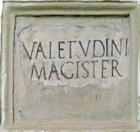
-
“VALETUDINI/ MAGISTER”
-
✴a travertine stele (AE 1947, 0064, date ??) [found under the convent of San Domenico,??, now in the Museo della Città], which commemorates C(aius) Carpelanu[s] C(ai) l(ibertus) Gratus sagarius (a manufacturer or dealer in woollen cloaks).
-
✴a cippus (CIL XI 5048, date ??) from an unknown location in Bevagna (now lost), which commemorated L(ucius) Aulius L(uci) l(ibertus) Optatus;
-
✴a travertine stele (CIL XI 7927, date ??) in the deposit of Palazzo Comunale, which commemorates T(itus) Edusius T(iti) l(ibertus) Chrestus and a second man whose name is almost lost;
Three other funerary inscriptions relate to men who were members of both the Novemviri Valetudinis and another priestly college, the Seviri Sacris Faciundis:
-
✴CIL XI 5044 (1st century AD) [in Palazzo Spetia] commemorates Statilia Nebris, the wife of C(aius) Arruntius] C(ai) l(ibertus) Hermes;
-
✴CIL XI 5053 (2nd half of the 1st century AD), from an unknown location, now lost, commemorates Penasia Pallas, the wife of Cn Serius Philetus ; and
-
✴CIL XI 5047 (2nd century AD) that was found outside Porta San Salvatore [now in the garden of Villa Contessine/Vigna Spetia] commemorates C(aius) Attius] Inuarius .
Lakes of Aiso and Aisillo

Lago dell’ Aiso
This image was supplied courtesy of Signor Giovanni Picuti
Detour B of Walk II runs parallel to what was probably the ‘via triumphalis described above, which ran from Bevagna to the sanctuary at the Laghetto dell’ Aisillo.
Lago dell’ Aiso
This freshwater lake, which has a diameter of 25 meters and a depth of 13 meters, is fed by an underwater spring at the centre of a vast aquifer under the plain between Bevagna, Cannara and Bastia Umbra. Its name derives from the Italian word for abyss, and it has remained a place of superstition well into modern times.
Bronze votive offerings (6th - 5th century BC) that were found here in the 18th century suggest that this was an ancient cult site that was probably devoted to a river god. Unfortunately, these important objects have been dispersed.
Laghetto dell’ Aisillo
Three even smaller ‘lakes’ associated with the Lago dell’ Aiso were documented in the early 20th century, each of which was identified by the diminutive “Aisillo”, followed by the name of the owner of the property on which it was found. Only one of these, documented then as the Aisillo Fanelli (on land that is now owned by the Lopparelli family) survives.
This circular lake, which has a diameter of about 5 meters and is surrounded by poplars, was excavated in 2004-5 and 2009-10, with results described by Matelda Albanesi and Maria Romana Picuti (referenced below). They also illustrate some of the architectural terracottas that were unearthed at this time, which apparently date to the early 2nd century BC. The presence of coins in the water suggests that it had a votive function: the earliest of these dated to the 2nd century BC while the latest dated to the reign of the Emperor Diocletian (284 - 305 AD).
In its present form, the ‘lake’ was surrounded by a rectangular courtyard with a peripheral portico: Simone Sisani (referenced below, 2012, at p. 418) asserted that this monumentalisation dated to the Augustan period, and that it probably coincided with the paving of the via triuphalis (above). He also suggested (at p. 419) that the cult site was dedicated to Valetudo.
The remains of this sanctuary are now covered by about 2 meters of sediment, which suggests that it might have become unusable when failures in land management reduced the area to an impassable swamp. However, it is likely that the advent of Christianity in the area in the 4th century led to the abandonment of the site prior to its physical deterioration.
Architectural Terracottas (2nd century BC)
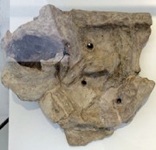
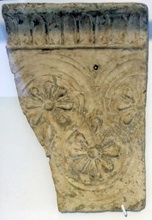
These two reliefs from the excavations of 2004-5, which are are now in the Museo Archeologico, Perugia, indicate the monumentalisation of the sanctuary in the 2nd century BC.
Other Finds
Finds from the site include:
-
✴a mosaic pavement (1st century BC) in one of the areas under the portico;
-
✴
-
✴some fragmentary votive statues;
-
✴a silver head that might have represented the Empress Livia, perhaps in the mode of “Salus Augusta”, an iconography propagated by her son, the Emperor Tiberius, in 22 AD; and
-
✴a silver disc embossed with a relief of the deity Victory, which was probably a votive offering made by a soldier, perhaps in the reign of the Emperor Trajan (98 - 117 AD).
[Are they exhibited anywhere ??]
Read more:
Via I Maggio
A. Feruglio et al. (Eds), “Mevania: Da Centro Umbro a Municipio Romano”, (1991) Perugia
Cult of Valetudo
G. Prosperi Valenti, “Sulla Valetudo di Bevagna”, in
L. Gasperini (Ed.), “Usus Veneratioque Fontium”, (2006) Tivoli (pp. 277-95)
G. Prosperi Valenti, “I Magistri Valetudinis di Mevania” Bollettino della Deputazione di Storia Patria per l’ Umbria, 102:1 (2005) 27-58
G. Prosperi Valenti, “Valetudo: Origine ed Aspetti del Culto nel Mondo Romano”, (1998) Rome
C. Letta, “I Culti di Vesuna e Valetudo tra Umbria e Marsica” in
G. Bonamente and F. Coarelli (Eds.), “Assisi e gli Umbri nell' Antichità: Atti del Convegno Internazionale (Assisi, 18-21 Dicembre 1991)”, (1996) Assisi
Laghetto dell’ Aisillo
M. Albanesi and M. R. Picuti, “Un Luogo di Culto d’ Epoca Romana all’ Aisillo di Bevagna (Perugia)”, Mélanges de l’École Française de Rome, 121 (2009) 133-179
Cult Sites in the Valle Umbra
S. Sisani, “I Rapporti tra Mevania e Hispellum nel Quadro del Paesaggio Sacro della Valle Umbra”, in
G. Della Fina (Ed.), “Il Fanum Voltumnae e i Santuari Comunitari dell’ Italia Antica”, (2012) Orvieto (pp. 409-64)
Return to Monuments of Bevagna.



